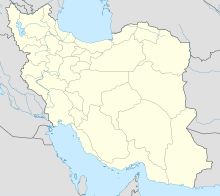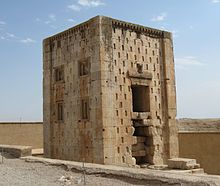Naqsh-e Rostam
Coordinates: 29 ° 59 ′ 20 ″ N , 52 ° 52 ′ 29 ″ E
Naqsch-e Rostam ( Persian نقش رستم, DMG Naqš-e Rostam , 'Representation of Rostam', rarely also in Persian تخته رستم, DMG Taḫte-ye Rostam , 'Table of Rostam') is an archaeological site in the Iranian province of Fars , six kilometers north of Persepolis near Shiraz . Here are four graves of Achaemenid great kings and a number of Sassanid rock reliefs. Before researchers in the 19th century recognized the meaning of the reliefs and also deciphered the inscriptions, the general opinion in Persia was that they were depictions from the life of their national hero Rostam , from which the name of the place can ultimately be traced.
Graves as images or representations as graves
The Persian King Dareios I had a rock grave carved into the stone on a steep rock wall that forms the border of a plateau . The cross-shaped shape of the grave goes back to older models. A relief above the entrance shows how the god Ahura Mazda presented the great king with the ring of rule. The king stands on a pedestal, which is carried by representatives of 28 peoples of the Persian Empire. There are inscriptions next to the depicted people. As a recently presented study shows, these inscriptions were originally colored. Ernst Herzfeld has inscriptions in 1923 clapped . These negatives are now in the archives of the Freer Gallery of Art and the Arthur M. Sackler Museum, Smithsonian Institution , in Washington, DC.
The central part is interpreted as a reproduction of the facade of the royal palace in Persepolis . The entrance to the burial chamber is lined with four pillars, two on each side. An inscription in Old Persian , Elamite and Babylonian reports on the reign of Darius and is also considered the testament of the great king and transmits his ideology of rule. The lower part of the grave facade is sanded, but free from other processing. The tomb has three main chambers, each with three sarcophagi carved out of the rock. The covers are only preserved in fragments. An Aramaic inscription from the late Achaemenid or early Hellenistic period was also found on the tomb of Darius, but it can no longer be deciphered due to its severe weathering.
Darius' successors Xerxes I , Artaxerxes I and Darius II also had tombs built in this rock face, most of which are exact copies of Darius I's tomb, but each with a different number of burial chambers and sarcophagi contained therein. There is also no inscription on Xerxes' grave.
The successors of Darius II, Artaxerxes II and Artaxerxes III. had tombs of the same kind built at Persepolis ; a third, unfinished grave is also available here, and Darius III is often the builder . called, but this is controversial in research.
Rock reliefs
A Sassanid inscription found in Persepolis proves that knowledge of the Achaemenid period (which had Persian blood and immigrated from Fars) was lost during the Sassanid period in Persia. Nevertheless, the Sassanid kings knew that there had once been a great and powerful Persian Empire. The tombs of Naqš-e Rostam were also known and viewed with respect by the Sassanids. Presumably to legitimize their rule, several Sassanid kings had eight large reliefs carved on the rock face, where the Achaemenid tombs are. Some reliefs are even immediately below it.
The first king to be immortalized here was Ardaschir I , the first Sassanid king . He adopts the representation shown on the tombs of how Ahuramazda presented him with the ring of lordship. However, both are shown here on horseback, and Ahuramazda, contrary to the Achaemenid depiction, where he hovers over the king, is at eye level with Ardaschir and is depicted as a human being. Under the horses lie two corpses: one, under Ardaschir, is the defeated Parthian King Artabanos IV , the other is Ahriman , Ahuramazda's diabolical opponent. On the horses there is an inscription in Middle Persian , Parthian and Greek that explains the scene. Ardaschir's son Shapur I had an almost identical relief made in Naqsch-e Rajab .
Ardaschir's son and successor Shapur I had a relief installed that shows him triumphant over the two defeated Roman emperors, Philip Arabs and Valerian , who were deported with regard to the second , Philip kneeling and Valerian with arms raised; He also had a trilingual inscription attached to the Ka'ba-ye Zarthouscht to celebrate his military successes (so-called res gestae divi Saporis in Greek, Middle Persian and Parthian).
Another relief shows a king identified as Hormizd I , who defeats an enemy in battle. Bahram II had two reliefs added, one above that of his predecessor Bahram I and one that was attached to a much older, probably Elamite relief. It shows Bahram II with his family and members of the court staff. The Elamite relief probably shows a royal or a divine figure. The second relief of Bahram shows, like that of his predecessor, the king on horseback, how he defeated an enemy that cannot be clearly identified. A portrait attached around 290 shows Kartir , the then highest priest ( Mobad ) of the Sassanid Empire. The inscription next to it describes his career.
The last relief shows Hormizd II fighting a mounted opponent, who can no longer be identified due to the severe weathering.
Kaʿbe-ye tender
In Naqsch-e Rostam there is also a nearly twelve-meter-high tower called Kaʿbe-ye Zartuscht , "Kaʿba (cube) of Zarathustra ". The purpose of the building, which was probably built under Darius I, is not known.
literature
- Philip Huyse: The trilingual inscription of Šabuhr I on the Ka'ba-i Zardušt (ŠKZ). 2 volumes, London 1999.
- Heidemarie Koch : Persepolis. Mainz 2001.
- Josef Wiesehöfer : The "dark centuries" of Persis. Munich 1994.
- Josef Wiesehöfer: Ancient Persia. Zurich 1994, new edition Düsseldorf 2005.
- Rüdiger Schmitt: The old Persian inscriptions of Naqsh-i Rustam and Persepolis. London 2000.
- Alexander Nagel: Everlasting Blues: Color and Epigraphic Habit in Achaemenid Persia, c. 520-330 BCE. (2009; PDF; 17 kB)
- Joseph von Hammer-Purgstall. Advertisement of the Siebenmeer: together with an index with words Germanischer […] Vienna 1831.
- Carl Ritter: The geography of Asia. Vol. VIII, Berlin 1854.
Web links
- Naqsh-e Rostam . In: Ehsan Yarshater (Ed.): Encyclopædia Iranica (English, including references)
- Jona Lendering: Naqš-e Rustam . In: Livius.org (English)
- Articles and picture gallery about Naqsch-e Rostam on Nirupars.com
- Ernst Herzfeld Persepolis Archive in the Freer Gallery of Art, Washington DC on asia.si.edu
Notes and individual references
- ↑ Carl Ritter : The geography of Asia. Vol. VIII, Berlin 1854, p. 935.




